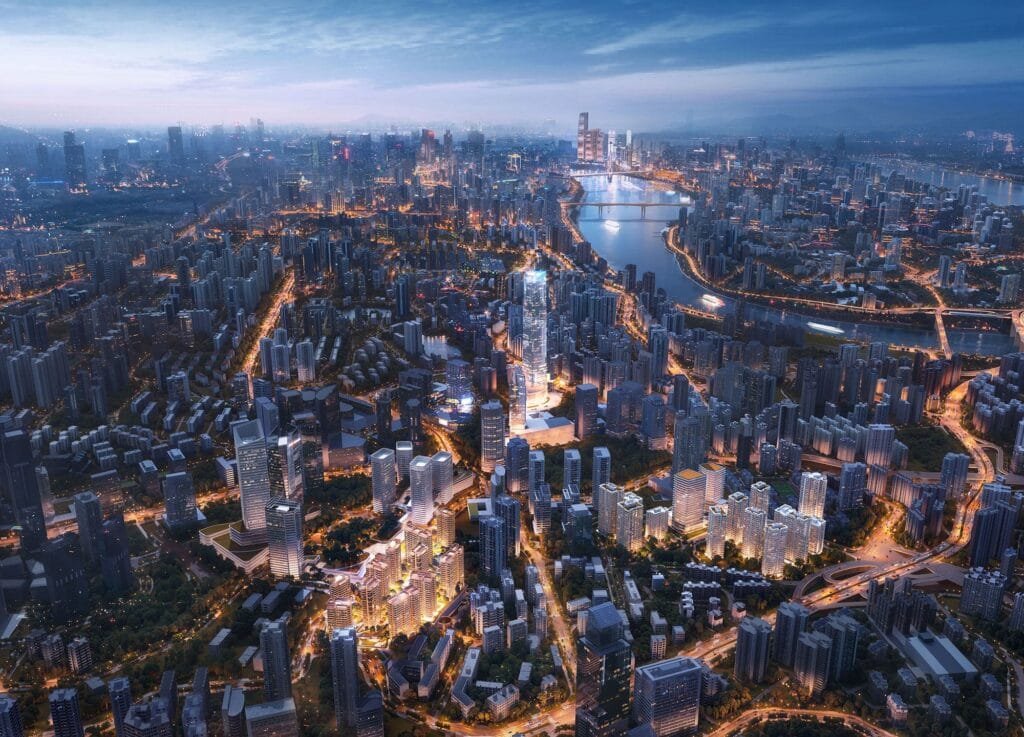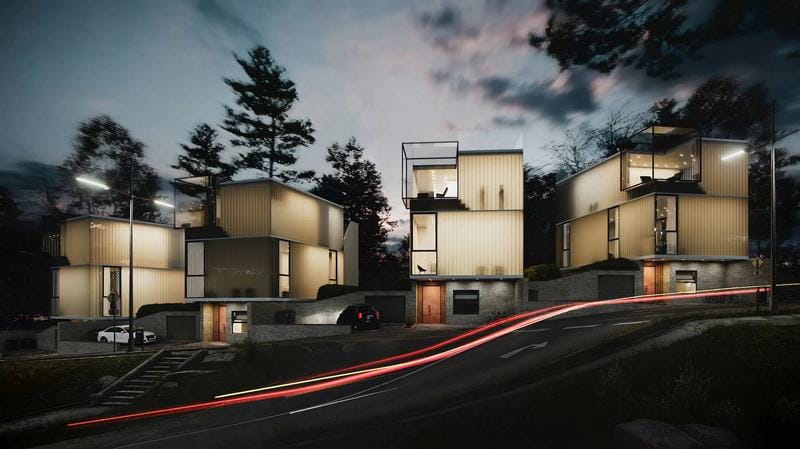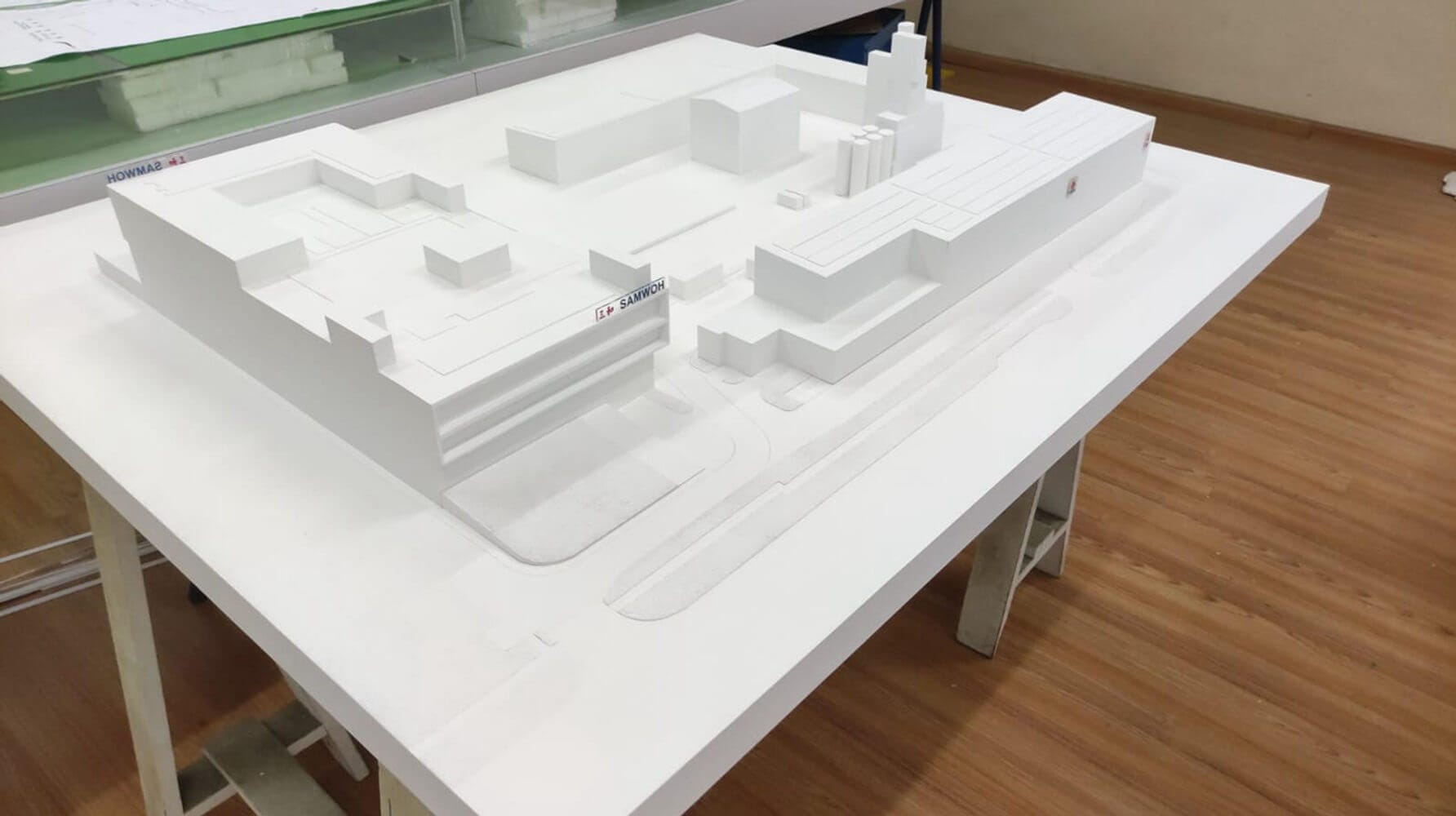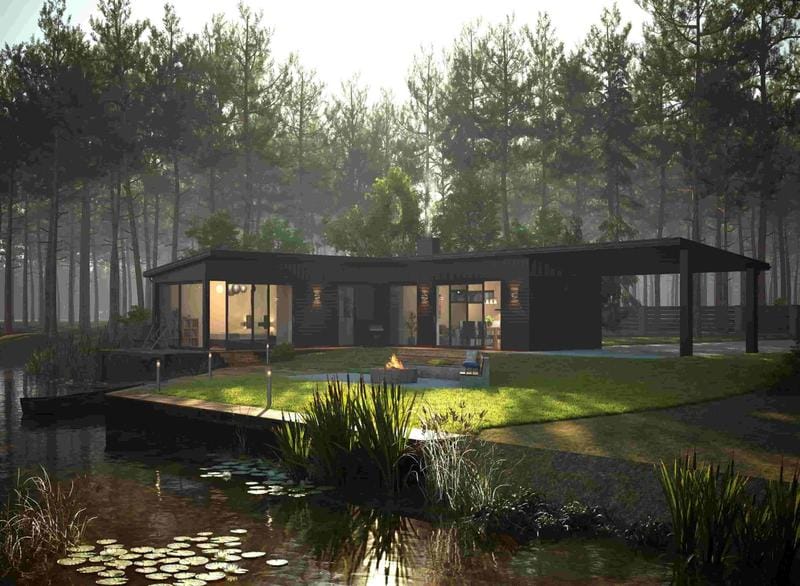Hai mai provato a spiegare un bellissimo, idea di design complessa, solo per essere incontrato con uno sguardo vuoto? Vedi la tonalità perfetta di verde salvia sulle pareti, il bagliore caldo di una luce a sospensione in ottone, la consistenza esatta di una poltrona boucle. Ma il tuo cliente? Stanno lottando per vederlo. Questa è la sfida più antica nell'interior design: Colmare il vasto divario tra la visione di un professionista e l'immaginazione di un cliente.
Per decenni, Abbiamo fatto affidamento sulle mood board, campioni di tessuto, e disegni 2D piatti. Hanno aiutato, Ma non hanno mai veramente catturato l'anima di uno spazio. Non potevano mostrare come la luce del mattino si filtrasse attraverso la finestra e ballerebbe sul pavimento. Non potevano trasmettere la sensazione di stare nella stanza finita.
Questo è cambiato tutto. Oggi, Abbiamo una soluzione rivoluzionaria: 3D Rendering di interior design.
Sommario
Questa potente tecnologia è diventata il gold standard nel mondo del design, E per una buona ragione. Non si tratta solo di creare una bella immagine; si tratta di creare chiarezza, fiducia, ed eccitazione. È una stretta di mano visiva che garantisce che tu e il tuo cliente stiate sognando esattamente lo stesso sogno. In questa guida definitiva, esploreremo ogni aspetto del rendering 3D. Lo scopriremo:
- I Fondamenti: Cosa sono esattamente i rendering e come funzionano?
- I vantaggi: Perché questo strumento non è negoziabile per il successo del design moderno.
- Il processo: Un dettagliato, viaggio passo dopo passo su come un rendering prende vita.
- Le opzioni: Esplorando i diversi tipi di rendering e se dovresti fare il fai-da-te o assumere un professionista.
- L'investimento: Una ripartizione trasparente di quanto costa il rendering 3D.
- Il futuro: Uno sguardo alle prospettive del mondo della visualizzazione del design.
Che tu sia un proprietario di casa nervoso per una grande ristrutturazione, un designer d'interni che mira a elevare le tue presentazioni, un architetto che progetta una nuova costruzione, o uno studente desideroso di apprendere gli strumenti del mestiere, questa guida è per te. Entriamo nel mondo del rendering 3D e trasformiamo l'immaginazione in realtà.
Parte 1: Cos'è un rendering di interior design? I Fondamenti Fondamentali
Prima di immergerci negli entusiasmanti vantaggi e processi, cominciamo con le basi. Capire cos'è un rendering e cosa non è è il primo passo per sfruttarne la potenza. È un concetto semplice con implicazioni profonde.
Che cos'è un rendering 3D di interior design?
Semplicemente, un rendering di interior design è un'immagine digitale che mostra come sarà uno spazio interno. Pensatelo come a Fotografia del futuro. Utilizzo di software specializzato, Un designer o un artista 3D crea un virtuale, Modello tridimensionale di una stanza e quindi genera un'immagine 2D realistica da quel modello.
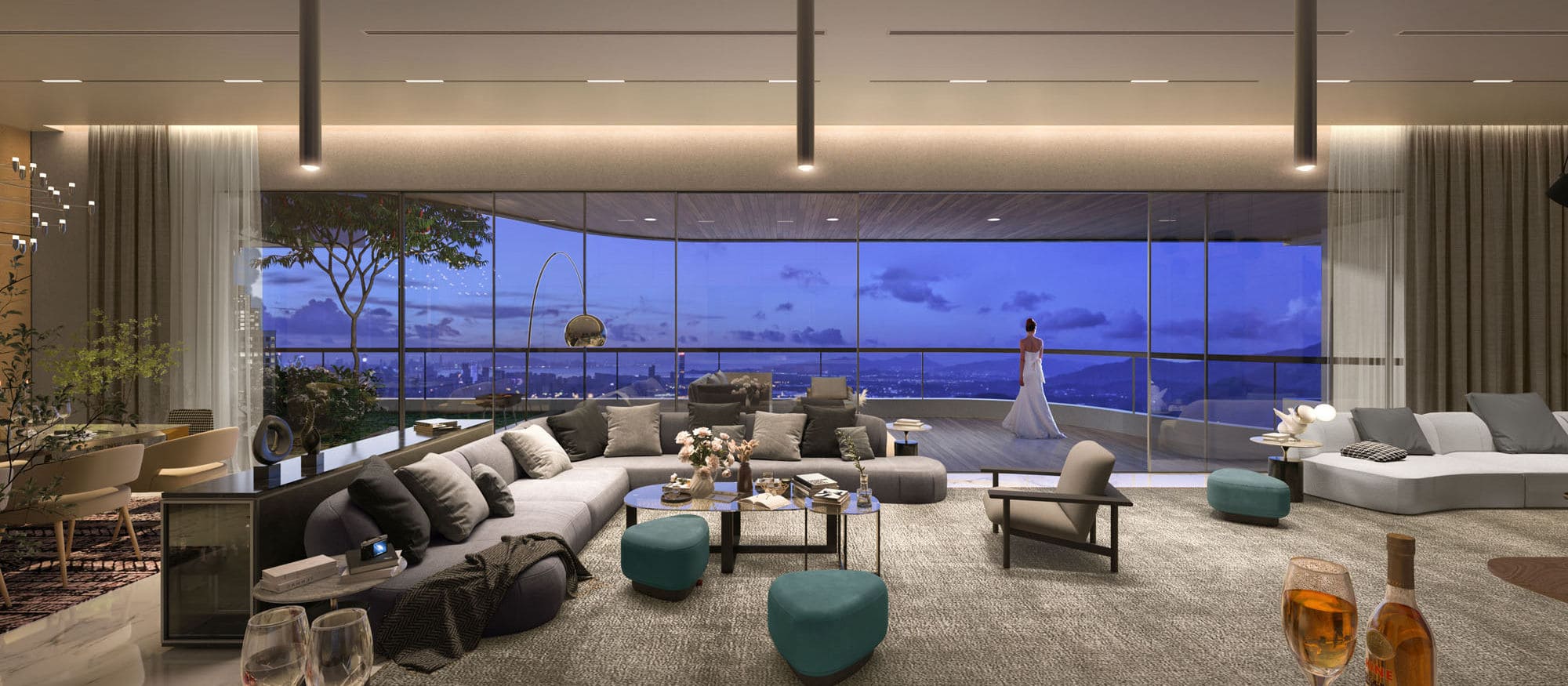
Questo non è solo uno schizzo semplice. Un rendering di alta qualità, spesso chiamato visualizzazione 3D o un rendering fotorealistico, comunica ogni dettaglio del design proposto. Questo include:
- Il layout preciso della stanza e dei mobili.
- I colori delle pareti, soffitti, e arredamento.
- Le trame e i materiali del pavimento, tessuti, e superfici.
- Come l'illuminazione naturale e artificiale interagirà con lo spazio.
- La scala e la proporzione di ogni elemento.
È lo strumento di comunicazione finale, Prendere tutti gli elementi astratti da una mood board e planimetria e assemblandoli in uno chiaro, coeso, e immagine visivamente sbalorditiva.
Una breve storia: Dagli schizzi disegnati a mano al realismo digitale
Per apprezzare dove siamo oggi, aiuta sapere da dove veniamo. Per generazioni, interior designer e architetti si affidavano a metodi manuali per trasmettere le loro idee. Schizzi prospettici disegnati a mano, dipinti ad acquerello, e intricate planimetrie 2D erano gli strumenti del mestiere. Questi metodi avevano un innegabile fascino artistico e sono ancora preziosi per una rapida concettualizzazione.
Tuttavia, avevano i loro limiti. Non potevano replicare perfettamente il complesso gioco di luci e ombre, né potrebbero essere facilmente modificati. Un cliente che desiderava vedere un colore diverso del divano significava iniziare un nuovo disegno da zero.
I semi del cambiamento furono piantati negli anni ’60, non nel design, ma in settori come l’ingegneria aerospaziale e automobilistica, dove sono stati creati i primi semplici modelli wireframe 3D. Come la tecnologia informatica è esplosa negli anni '80 e '90, Questi strumenti sono diventati più sofisticati e si sono fatti strada nell'architettura. Negli anni 2000, Il software è diventato abbastanza potente e accessibile da rendere il 3D fotorealistico di rendere uno strumento praticabile per gli interior designer di tutto il mondo. Quello che una volta era una nicchia, La tecnologia costosa è ora lo standard del settore, Abilitare un livello di chiarezza e collaborazione precedentemente inimmaginabile.
Quali sono i componenti principali di un rendering 3D?
Uno straordinario rendering fotorealistico non è magico: è il risultato di quattro componenti digitali principali che lavorano insieme in perfetta armonia. Comprendere questi elementi costitutivi ti aiuta ad apprezzare l'arte e le abilità tecniche coinvolte.
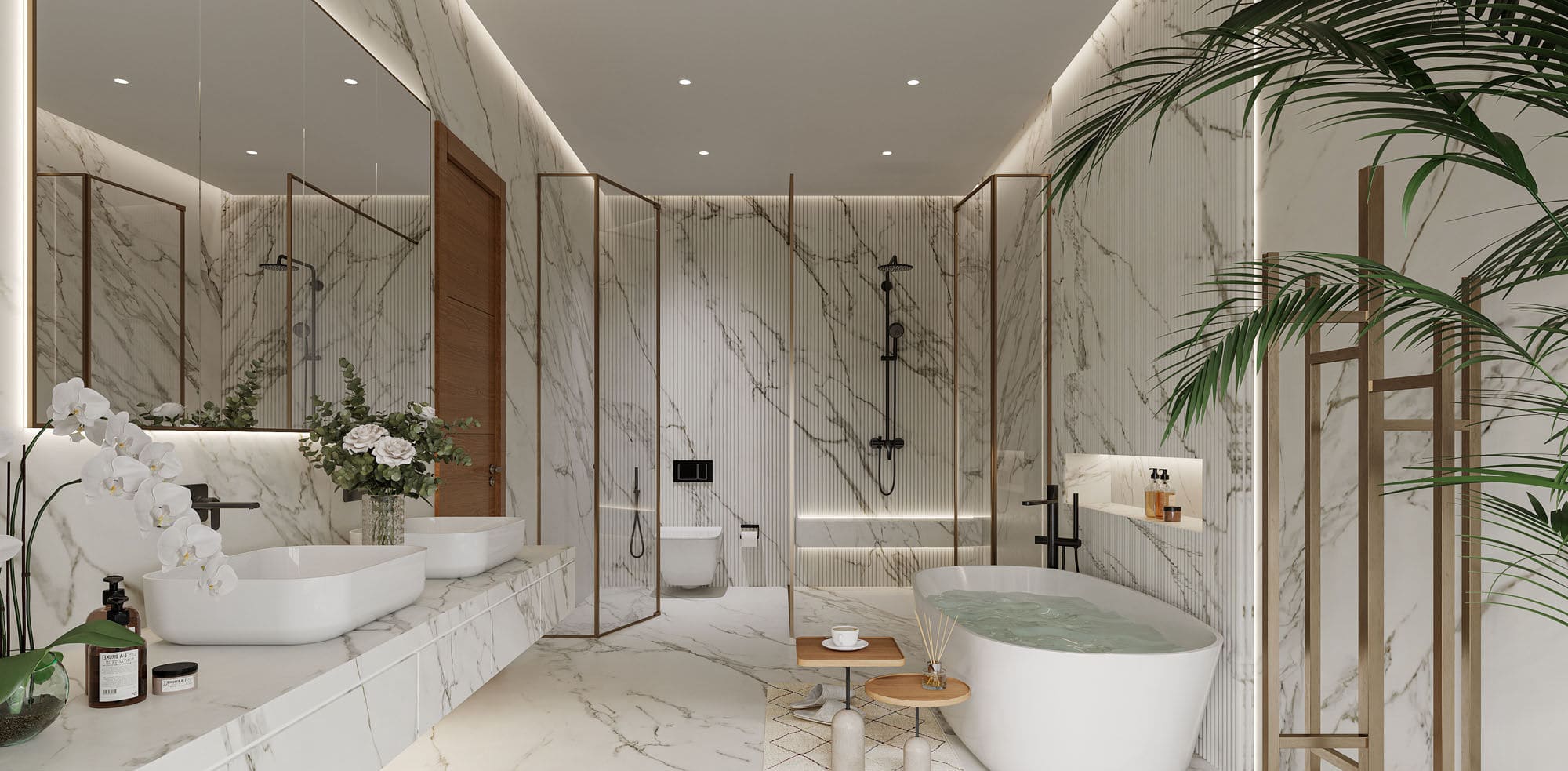
Modelli: Lo scheletro digitale
La fondazione di qualsiasi rendering è il modello 3D. Questa è l'architettura digitale della scena. Gli artisti creano le forme e le strutture geometriche di tutto ciò che vedi: le pareti, finestre, e porte che formano la stanza, così come ogni mobile, ogni lampada, e ogni vaso decorativo. Questo digitale “scheletro” definisce la dimensione, forma, e posizionamento di ogni oggetto nello spazio.
Trame e materiali: Il realistico “Pelle”
Un modello 3D da solo è solo una raccolta di forme grigie. Ciò che lo dà vita è l'applicazione di materiali e trame. Questo è il digitale “pelle” che dà a ogni superficie il suo aspetto realistico. Gli artisti applicano mappe di trama: immagini di materiali ad alta risoluzione come la venatura del legno, tessuti in tessuto, vene di marmo, o finiture in metallo: ai modelli. Quindi perfezionano le proprietà come:
- Riflessione: Quanta luce una superficie rimbalza.
- Lucentezza: Se una superficie è lucida (come il cromo lucido) o opaco (come un pavimento di pietra).
- Urto/Spostamento: Piccoli dettagli superficiali che creano l'illusione della trama, come le scanalature del legno o i ciuffi di un tappeto.
Illuminazione: L'anima della scena
L’illuminazione è senza dubbio l’elemento più critico per il realismo e l’atmosfera. Senza una buona illuminazione, anche i migliori modelli e texture sembreranno piatti e finti. L'artista allestisce un sistema di illuminazione completo che imita il mondo reale:
- Luce naturale: Un digitale “sole e cielo” sistema che proietta luci e ombre realistiche attraverso le finestre, cambiando a seconda dell'ora del giorno.
- Luce artificiale: Posizionamento di versioni digitali di apparecchi di illuminazione come sospensioni, Lampade, e riflettori, ciascuno emette luce proprio come farebbe la sua controparte nel mondo reale.
Questa illuminazione interagisce con tutti i materiali della scena, creando i riflessi luminosi, ombre morbide, e riflessi sottili che rendono uno spazio reale e invitante.
Prospettiva e fotocamera: L'occhio dello spettatore
Finalmente, L'intera scena è vista tramite una fotocamera digitale. L'artista sceglie la posizione perfetta della fotocamera, angolo, e lunghezza focale per creare una composizione avvincente che mette in mostra meglio il design. Ciò determina la prospettiva - come gli oggetti appaiono l'uno rispetto all'altro - e assicura che l'immagine finale si senta equilibrato e professionale, Proprio come una fotografia scattata da un abile fotografo architettonico.
3D rendering vs. Staging virtuale: Qual è la differenza?
Questo è uno dei punti più comuni di confusione nel settore. Mentre entrambi gli strumenti vengono utilizzati per visualizzare una proprietà, Sono processi fondamentalmente diversi con applicazioni diverse. Chiariamolo.

Staging virtuale inizia con a fotografia reale di un esistente, stanza vuota. Un artista digitale utilizza quindi un software per aggiungere mobili e decorazioni a quella foto. È uno strumento incredibilmente utile per gli agenti immobiliari che vogliono aiutare i potenziali acquirenti a vedere il potenziale di una casa sfitta. Il suo scopo principale è quello di “palcoscenico” uno spazio esistente senza il costo e il fastidio dei mobili fisici.
Rappresentazione 3D interna, d'altra parte, crea un scena interamente digitale da zero. Non esiste una fotografia iniziale. L'intera stanza, le pareti, la pavimentazione, l'illuminazione, i mobili: sono costruiti in un ambiente 3D. Questo lo rende lo strumento perfetto per progetti che ancora non esistono, come un nuovo edificio, una ristrutturazione importante, o un concetto di design completamente nuovo.
“Pensatela in questo modo: L'allestimento virtuale è come decorare digitalmente una stanza reale. 3Il rendering è come costruire e decorare una stanza digitale da zero.”
Ecco una semplice tabella per evidenziare le differenze chiave:
| Caratteristica | Staging virtuale | Rappresentazione 3D interna |
|---|---|---|
| Punto di partenza | Una vera fotografia di una stanza vuota | Un modello 3D digitale creato dai piani |
| Flessibilità creativa | Limitato. Non puoi cambiare l'architettura della stanza o l'angolo della fotocamera della foto originale. | Illimitato. Hai il controllo completo su ogni elemento, compreso il layout, Materiali, e viste della fotocamera. |
| Caso d'uso primario | Marketing esistente, Proprietà vacanti in vendita o affitto. | Visualizzazione di nuove costruzioni, ristrutturazioni, e interior design concettuali. |
| Meglio per | Agenti immobiliari e gestori di proprietà. | Interior designer, architetti, e sviluppatori di proprietà. |
Entrambi sono preziosi, Ma servono bisogni diversi. Conoscere la differenza ti aiuta a scegliere lo strumento giusto per il tuo progetto specifico.
Parte 2: Perché ne hai bisogno: 10 I vantaggi rivoluzionari del rendering 3D
Ora che sappiamo cosa sono i rendering, esploriamo perché sono diventati così indispensabili. I vantaggi vanno ben oltre la semplice immagine; influiscono sul tuo budget, la tua cronologia, le tue relazioni con i clienti, e il tuo successo complessivo.
1. Risparmia tempo e denaro: Il ritorno tangibile sull'investimento
Questo è il vantaggio più pratico e convincente. Apportare modifiche durante la fase di progettazione è facile ed economico. Apportare modifiche durante la costruzione? È un incubo di ritardi e sforamenti del budget. Un rendering 3D ti consente di individuare potenziali difetti di progettazione prima che un singolo chiodo venga piantato.
Immagina che il rendering riveli che l'isola della cucina pianificata è troppo grande, limitando il flusso di lavoro. O che il posizionamento di un divano blocchi una porta quando viene aperta. Identificare questi problemi digitalmente non costa nulla. Ripararli dopo che sono stati costruiti potrebbe costare migliaia. Inoltre, immagini chiare portano a decisioni e approvazioni più rapide da parte dei clienti, che riduce la tempistica complessiva del progetto e fa risparmiare denaro sulla manodopera.
2. Migliora la comunicazione e crea una fiducia indissolubile da parte del cliente
Il design degli interni è pieno di gergo tecnico e concetti astratti. Termini come “flusso spaziale,” “spazio negativo,” e anche i nomi di materiali specifici possono creare confusione per i clienti. Un rendering 3D taglia il rumore. È un linguaggio visivo universale che tutti possano capire immediatamente. Non c’è spazio per interpretazioni errate.
Quando un cliente vede un'immagine fotorealistica che corrisponde perfettamente alla visione che aveva in testa, crea un'incredibile quantità di fiducia. Si sentono ascoltati e compresi. Questa chiarezza collaborativa è il fondamento di un ottimo rapporto designer-cliente e di un progetto di successo.
3. Migliora il processo decisionale di progettazione e riduce drasticamente le revisioni
Una delle maggiori fonti di ansia del cliente è l’incertezza. “Mi piacerà quel colore su tutte e quattro le pareti?” “Quel divano è troppo moderno per la stanza??” Un rendering 3D elimina queste congetture. Offre a “provare prima di acquistare” esperienza per le scelte progettuali.
Vuoi confrontare un buio, tavolozza di colori lunatica con una luce, uno arioso? Un artista può creare due versioni. Non riesco a decidere tra un piano di lavoro in marmo o in quarzo? Puoi vederli entrambi nel contesto. Questa capacità di sperimentare visivamente consente ai clienti di prendere decisioni sicure, il che significa meno ripensamenti e costose revisioni su tutta la linea.
4. Crea un marketing potente, Marchio, e strumento di vendita
Per professionisti, 3I rendering d sono una miniera d'oro di marketing.
- Per interior designer: Puoi costruire uno splendido portafoglio del tuo miglior lavoro, compresi i progetti che non sono ancora stati costruiti ancora. Questo ti consente di mostrare le tue abilità e lo stile unico per attirare nuovi clienti.
- Per gli sviluppatori immobiliari: Puoi iniziare a commercializzare e vendere proprietà “Off-Plan” Molto prima che la costruzione sia finita. Questi elementi visivi creano buzz e acquirenti sicuri all'inizio del processo.
- Per le compagnie di mobili: I prodotti possono essere presentati in perfettamente curati, sale digitali aspirazionali senza la spesa per la costruzione di set fisici e l'organizzazione di servizi fotografici.
Queste immagini di alta qualità sono perfette per i siti Web, social media, brochure, e presentazioni, Dare al tuo marchio un aspetto lucido e professionale.
5. Dà un forte vantaggio competitivo in un mercato affollato
Nel panorama competitivo di oggi, presentarsi alla presentazione di un cliente con planimetrie 2D e una moodboard non è più sufficiente. Un concorrente che presenta uno straordinario, Il rendering 3D fotorealistico dello spazio futuro del cliente dimostra immediatamente un livello di professionalità più elevato, competenza, e dedizione. Offrire la visualizzazione 3D ti distingue. Dimostra che hai investito in strumenti moderni e, Ancora più importante, nel garantire che il tuo cliente abbia totale chiarezza e fiducia nel suo progetto.
6. Fornisce una visualizzazione dettagliata e accurata
Un rendering non mostra solo l’idea generale; mostra i dettagli intricati. Puoi vedere il modello preciso della piastrella, la trama della carta da parati, le sottili venature del legno. Questo livello di dettaglio garantisce che ogni sfumatura del design sia vista e apprezzata, senza lasciare nulla all'immaginazione.
7. Promuove una profonda connessione emotiva
Un ottimo design non dipende solo dall’aspetto di uno spazio; si tratta di come ci si sente. Un rendering di alta qualità, con la sua illuminazione realistica e i dettagli scelti con cura, può evocare una potente risposta emotiva. Quando un cliente vede un warm, immagine invitante del loro futuro soggiorno, non vedono solo un disegno: vedono se stessi vivere lì, creare ricordi. Questa connessione emotiva è preziosa per ottenere l’approvazione di un progetto.
8. Consente una stima dei costi più accurata
Quando ogni singolo elemento di un progetto viene modellato e visualizzato, dalle specifiche lampade al numero esatto di maniglie del mobile, diventa molto più semplice creare un budget accurato. Questo inventario visivo dettagliato aiuta a prevenire costi imprevisti e garantisce che il progetto rimanga in linea finanziariamente.
9. Semplifica la collaborazione del team
Un rendering 3D funge da unica fonte di verità per l'intero team di progetto. Il progettista d'interni, l'architetto, il costruttore, e i vari subappaltatori possono fare tutti riferimento allo stesso insieme di immagini. Ciò garantisce che tutti siano allineati sull’obiettivo finale, riducendo al minimo gli errori e le comunicazioni errate tra le diverse operazioni.
10. Aumenta il coinvolgimento e la soddisfazione del cliente
Il processo di rendering è intrinsecamente collaborativo. I clienti vedono il loro spazio prendere forma e forniscono feedback lungo il percorso. Questo coinvolgimento li fa sentire partner attivi nel percorso di progettazione, non solo destinatari passivi. Questo impegno porta a un prodotto finale che riflette veramente la loro visione, con conseguente maggiore soddisfazione e una maggiore probabilità di referenze.
Parte 3: Lo spettro della visualizzazione: Tipi chiave di rendering di interni
Non tutti i rendering sono uguali. Il tipo che scegli dipende dalla fase del tuo progetto, i tuoi obiettivi, e il tuo budget. Esploriamo lo spettro di opzioni, da semplici schizzi a mondi virtuali completamente immersivi.
Lo standard del settore: 3D Rendering di immagini fisse
Questa è la forma più comune e versatile di rendering 3D. È un singolo, immagine statica ad alta risoluzione, come una fotografia digitale, dello spazio proposto. All'interno di questa categoria, ci sono due stili principali:

Rendering concettuali
Spesso fatto in a “argilla” o stile monocromatico, questi rendering si concentrano sul quadro generale: modulo, disposizione, scala, e il volume complessivo dello spazio. Tralasciano deliberatamente colori e texture dettagliati per consentire discussioni sugli elementi architettonici e spaziali principali. Sono perfetti per le prime fasi di un progetto.
Rendering fotorealistici
Questo è l'obiettivo finale della maggior parte dei progetti. L'obiettivo è creare un'immagine che sia indistinguibile da una fotografia reale. Ogni dettaglio, dai sottili riflessi nella finestra alle morbide rughe su un cuscino di lino, è realizzato meticolosamente. Questi vengono utilizzati per le presentazioni al cliente finale, materiali di marketing, e garantire l'approvazione del progetto.
Esperienze immersive: 360° Panorami e Tour Virtuali
Un passo avanti rispetto a un'immagine fissa, un panorama a 360° consente allo spettatore di “in piedi” in un punto fisso all'interno della stanza virtuale e guardati intorno in qualsiasi direzione: verso l'alto, giù, e tutt'intorno. Collegando insieme diversi di questi punti panoramici, puoi creare un semplice tour virtuale.

“Una panoramica a 360° non significa più semplicemente mostrare al tuo cliente un'immagine della stanza; li stai lasciando stare al suo interno.”
Questo formato è fantastico per aiutare i clienti ad avere un vero senso dello spazio e delle sue proporzioni. È particolarmente efficace per i clienti remoti che non possono visitare un sito di persona.
Narrazione dinamica: Wallough e flythrough animati
Se un fermo immagine è una fotografia, una guida animata è un film. Si tratta di un video pre-renderizzato che guida lo spettatore in un viaggio cinematografico attraverso lo spazio progettato. La fotocamera può funzionare senza problemi “camminare” da una stanza all'altra, panoramica attraverso bellissimi dettagli, E “volare” sul layout per mostrare le connessioni tra gli spazi. Questi sono ideali per progetti su larga scala come gli hotel, ristoranti, o case di lusso, dove comprendere il flusso e l'esperienza del movimento attraverso lo spazio è fondamentale.
L'avanguardia: Realtà virtuale (VR) e realtà aumentata (Ar)
È qui che la visualizzazione del progetto diventa veramente interattiva.
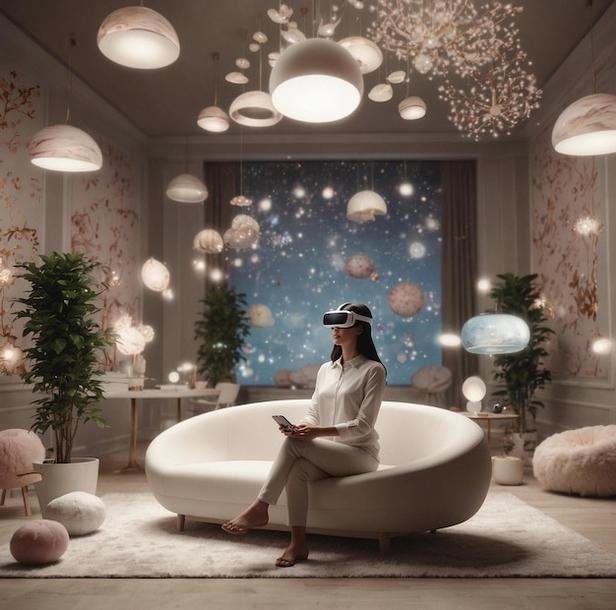
Realtà virtuale (VR) Rendering
Questa è l'esperienza più coinvolgente possibile. Il cliente indossa un visore VR e viene trasportato digitalmente nel modello 3D. Possono “camminare” liberamente nello spazio, all'a 1:1 scala, come se fossero realmente lì. Possono osservare i dettagli da vicino, ottenere un vero senso dell'altezza del soffitto, e vivere lo spazio in modo profondamente personale. È uno strumento potente che sta rivoluzionando le presentazioni dei clienti di fascia alta.
Realtà aumentata (Ar) Rendering
L’AR non crea un mondo completamente virtuale; Invece, sovrappone elementi digitali al mondo reale, visualizzati tramite smartphone o tablet. Per interior design, ciò significa che un cliente può utilizzare la fotocamera del proprio telefono per guardare il proprio reale, soggiorno esistente e posiziona digitalmente un modello 3D di un nuovo divano nello spazio per vedere come si adatta. È un modo pratico e accessibile per testare nuovi mobili e decorazioni in un contesto reale.
| Tipo di rendering | Descrizione | Miglior caso d'uso |
|---|---|---|
| 3D Immagine fissa | Un singolo, fotorealistico “fotografia digitale.” | Presentazioni finali, marketing, portfolio, approvazioni del cliente. |
| 360°Panorama | Un'immagine interattiva che permette allo spettatore di guardarsi intorno da un punto fisso. | Dare ai clienti un migliore senso dello spazio, presentazioni a distanza. |
| Animazione/procedura dettagliata | Un video tour cinematografico attraverso lo spazio. | Progetti su larga scala (Hotel, case di lusso) per mostrare flusso ed esperienza. |
| Realtà virtuale (VR) | Un pienamente immersivo, esperienza percorribile utilizzando un auricolare. | Presentazioni per clienti di fascia alta, convalida del progetto presso a 1:1 scala. |
Parte 4: Il flusso di lavoro professionale: Come viene creato un rendering 3D, Passo-passo
Creare un rendering 3D mozzafiato è un processo meticoloso che unisce abilità tecnica e visione artistica. Mentre le specifiche possono variare, la maggior parte degli studi professionali segue uno schema strutturato, flusso di lavoro in più fasi per garantire efficienza e qualità. Ripercorriamo il viaggio dall'idea iniziale all'immagine finale.
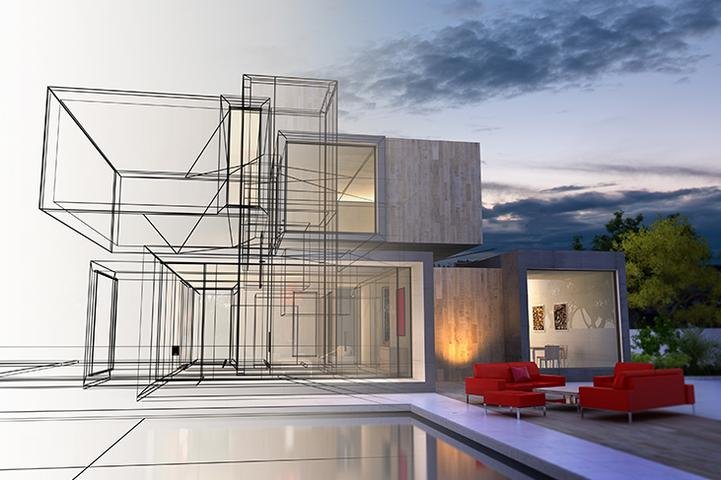
Fare un passo 1: Il briefing & Raccolta di informazioni
Questa è la fase più critica. La qualità del rendering finale dipende interamente dalla qualità delle informazioni iniziali. Un designer fornisce all'artista o allo studio 3D un brief completo del progetto, che in genere include:
- Piani architettonici: 2P Planimetrie, Altitudini, e le planimetrie del soffitto con misurazioni precise sono il minimo assoluto. Se esiste già un modello 3D, è ancora meglio.
- Tavole dell'umore & Riferimenti: Una raccolta di immagini che definiscono lo stile desiderato, atmosfera, e tavolozza dei colori.
- FF&Programma E: Un elenco di mobili specifici, Infissi, e attrezzature.
- Suggerimenti sull'angolazione della telecamera: Il progettista suggerirà spesso le viste chiave che desidera vedere.
Più dettagliato è il brief, più agevole sarà il processo.
Fare un passo 2: 3D Modellazione – Costruire l'architettura digitale
Con il brief in mano, l'artista 3D inizia a costruire la scena digitale. Iniziano utilizzando i piani 2D “estrudere” le pareti, creando l'involucro base della stanza. Successivamente modellano tutti gli elementi architettonici fissi, come mobili e caminetti, e poi modella o importa tutti i mobili e gli oggetti decorativi.
Fare un passo 3: Configurazione della fotocamera – Definire la vista
All'inizio del processo, l'artista imposterà gli angoli di ripresa proposti e li invierà semplici “argilla” opinioni al progettista per l'approvazione. Questo passaggio cruciale garantisce che il rendering finale sarà incorniciato perfettamente per catturare l'essenza del design.
Fare un passo 4: Strutturazione & Materiali – Applicazione delle superfici realistiche
È qui che la scena inizia a prendere vita. L'artista applica meticolosamente i materiali digitali specificati su ogni superficie del modello 3D, proprietà di messa a punto per imitare come si comporterebbero nel mondo reale.
Fare un passo 5: Illuminazione – Creare l'umore e l'atmosfera
L'artista allestisce un sofisticato sistema di illuminazione, utilizzando un sole e un cielo digitali per la luce naturale e posizionando versioni digitali di lampade e sospensioni per la luce artificiale. Questo crea l'atmosfera e il realismo della scena.
Fare un passo 6: Aggiunta “Entourage” – Dare vita alla scena
La magia di un rendering credibile spesso risiede nel “entourage”-il piccolo, dettagli attentamente posizionati che suggeriscono la presenza umana, come una coperta drappeggiata o una pila di libri. Questi elementi fanno sì che lo spazio sembri vissuto.
Fare un passo 7: Il processo di rendering – Dal modello 3D all'immagine 2D
Questo è un processo puramente computazionale in cui il computer calcola le interazioni della luce con ogni superficie per generare l'immagine finale. Questa operazione può richiedere da pochi minuti a molte ore.
Fare un passo 8: Post-produzione & Revisioni – Il polacco finale
IL “crudo” il rendering viene inserito in un programma di fotoritocco per le modifiche finali come la correzione del colore e la regolazione del contrasto. Dopo una revisione del cliente ed eventuali revisioni minori, la piena risoluzione, viene consegnata un'immagine lucida.
Parte 5: La decisione pratica: Fai da te vs. Esternalizzazione dei rendering 3D
COSÌ, sei convinto della potenza del rendering 3D. La prossima grande domanda è: dovresti imparare a farlo da solo, o dovresti assumere un professionista? Entrambi i percorsi hanno i loro meriti, e la scelta giusta dipende dal tuo tempo, budget, e obiettivi a lungo termine.
Il percorso fai da te: Dovresti creare i tuoi rendering?
Per i creativi curiosi e tecnicamente inclini, imparare a creare i propri rendering può essere un'abilità incredibilmente gratificante. Tuttavia, è essenziale comprendere l’impegno coinvolto.
Il software richiesto
Avrai bisogno di una combinazione di software di modellazione 3D e un motore di rendering. Ecco alcune delle scelte più popolari:
| Tipo di software | Programmi popolari | Meglio per |
|---|---|---|
| 3D Modellazione | Sketchup, Autodesk 3ds max, Miscelatore, Cinema 4D | Costruire il modello 3D principale dello spazio e dei mobili. SketchUp è ottimo per i principianti, mentre Blender è una potente opzione gratuita. |
| Motore di rendering | V-ray, Corona Renderer, Lumion, Encape | Collegandoti al tuo software di modellazione per aggiungere materiali realistici, illuminazione, e generare l'immagine finale. |
Tieni presente che il software professionale può comportare costi di abbonamento significativi, spesso migliaia di dollari all'anno.
L'investimento hardware
3Il rendering D è uno dei compiti più impegnativi che puoi chiedere a un computer. Avrai bisogno di un potente computer desktop con una scheda grafica di fascia alta (GPU) e una grande quantità di RAM per gestire scene complesse. Questo può essere un investimento di diverse migliaia di dollari.
L'impegno di tempo e competenze
“Roma non è stata costruita in un giorno, e nemmeno l'abilità del rendering fotorealistico. È un mestiere che richiede centinaia di ore per imparare e migliaia di ore per padroneggiarlo.”
Questo è il fattore più significativo. Ottenere un risultato veramente fotorealistico richiede una curva di apprendimento ripida. Per un professionista del design impegnato, il tempo dedicato all'apprendimento del software viene spesso sottratto al lavoro di progettazione principale e alla gestione del cliente.
Il verdetto: Il percorso fai-da-te è più adatto a studenti o designer che desiderano rendere la visualizzazione 3D una parte centrale delle proprie competenze professionali. Per la maggior parte dei designer attivi, l’outsourcing è più efficiente.
La via dell'outsourcing: Come scegliere un partner per il rendering 3D
La stragrande maggioranza degli interior designer sceglie di esternalizzare le proprie esigenze di rendering a studi specializzati o artisti freelance. Ciò consente loro di accedere a risultati di livello mondiale senza costi generali. Ma come trovare il partner giusto??

Ecco una lista di controllo per guidare la selezione:
- ✅ Rivedi il loro portafoglio: La qualità del loro lavoro soddisfa i tuoi standard? Il loro stile artistico è in linea con l'estetica del tuo design??
- ✅ Cerca la specializzazione in Interior Design: Uno studio esperto in interni avrà una migliore comprensione della scala, arredamento, e illuminazione.
- ✅ Valutare il flusso di lavoro e la comunicazione: Uno studio professionale dovrebbe avere un processo chiaro e un project manager dedicato.
- ✅ Controlla i tempi di consegna: Assicurati che il loro programma di consegna sia in linea con le scadenze del tuo progetto.
- ✅ Conferma Garanzie e Sicurezza: Assicurati che lo studio sia disposto a firmare un accordo di non divulgazione (Nda) per proteggere il tuo lavoro.
Prenderti il tempo necessario per valutare le tue opzioni e trovare il partner giusto ti ripagherà in termini di qualità delle tue immagini e fluidità del tuo progetto.
Parte 6: L'investimento: Quanto costano i servizi di rendering di interni 3D?
Questa è spesso la prima domanda nella mente di tutti. Il costo di un rendering 3D può variare notevolmente in base a una serie di fattori. Comprendere questi fattori ti aiuterà a pianificare il tuo budget in modo efficace.
Qual è il costo medio per un rendering di interni?
Mentre i prezzi sono sempre specifici del progetto, possiamo fornire alcune fasce di prezzo generali per una singola immagine fissa per darti un'idea approssimativa.
| Livello di qualità di rendering | Costo stimato per immagine (Dollaro statunitense) | Descrizione |
|---|---|---|
| Di base / Concettuale | $350 - $750 | Ottimo per l'esplorazione della progettazione in fase iniziale, spesso con modelli e illuminazione più semplici. |
| Di fascia media / Professionale | $750 - $1,500 | Il livello più comune. Alta qualità, risultati fotorealistici adatti per presentazioni ai clienti. |
| Di fascia alta / Iperrealistico | $1,500 - $5,000+ | Qualità di alto livello, spesso indistinguibili da una fotografia. Utilizzato per progetti di lusso e pubblicità di fascia alta. |
Le animazioni e le esperienze VR hanno un prezzo in base al progetto e in genere iniziano a poche migliaia.
Quali sono i fattori chiave che influenzano i prezzi di rendering?
COSÌ, ciò che rende un costo di rendering $500 e un altro $5,000? Dipende dalla quantità di lavoro e di competenze richieste. Ecco i principali fattori di costo:
1. Complessità del disegno e della geometria
Un semplice, un soggiorno minimalista è più economico da modellare rispetto a una grande sala da pranzo con intricate modanature a corona e mobili decorati.
2. Livello di dettaglio e fotorealismo
Raggiungere quell'ultimo 10% del realismo richiede una quantità sproporzionata di tempo e abilità, che aumenta il costo.
3. Risoluzione dell'immagine
Un'immagine con risoluzione web standard è meno costosa di un'immagine ad altissima risoluzione necessaria per una stampa di grande formato.
4. Numero di visualizzazioni e revisioni
Ordinare più viste della stessa stanza spesso comporta uno sconto. Ulteriori cicli di revisioni oltre a quanto incluso aumenteranno il costo.
5. Tempo di consegna
Un lavoro urgente che richiede agli artisti di fare gli straordinari verrà quasi sempre accompagnato da una tariffa prioritaria.
6. Qualità dei materiali forniti
Fornire un altamente dettagliato, un brief ben organizzato può ridurre il tempo dell’artista e potenzialmente abbassare i costi.
Parte 7: Applicazioni nella pratica: Esempi di rendering di interni per tipologia di stanza
La potenza del rendering 3D può essere compresa meglio attraverso esempi del mondo reale. Gli obiettivi di un rendering possono cambiare a seconda dello spazio specifico da progettare.
Rendering del soggiorno
Come il cuore della casa, il soggiorno si concentra sulla creazione di un senso di comfort, stile, e personalità, presentando mobili ben disposti e un'atmosfera accogliente.
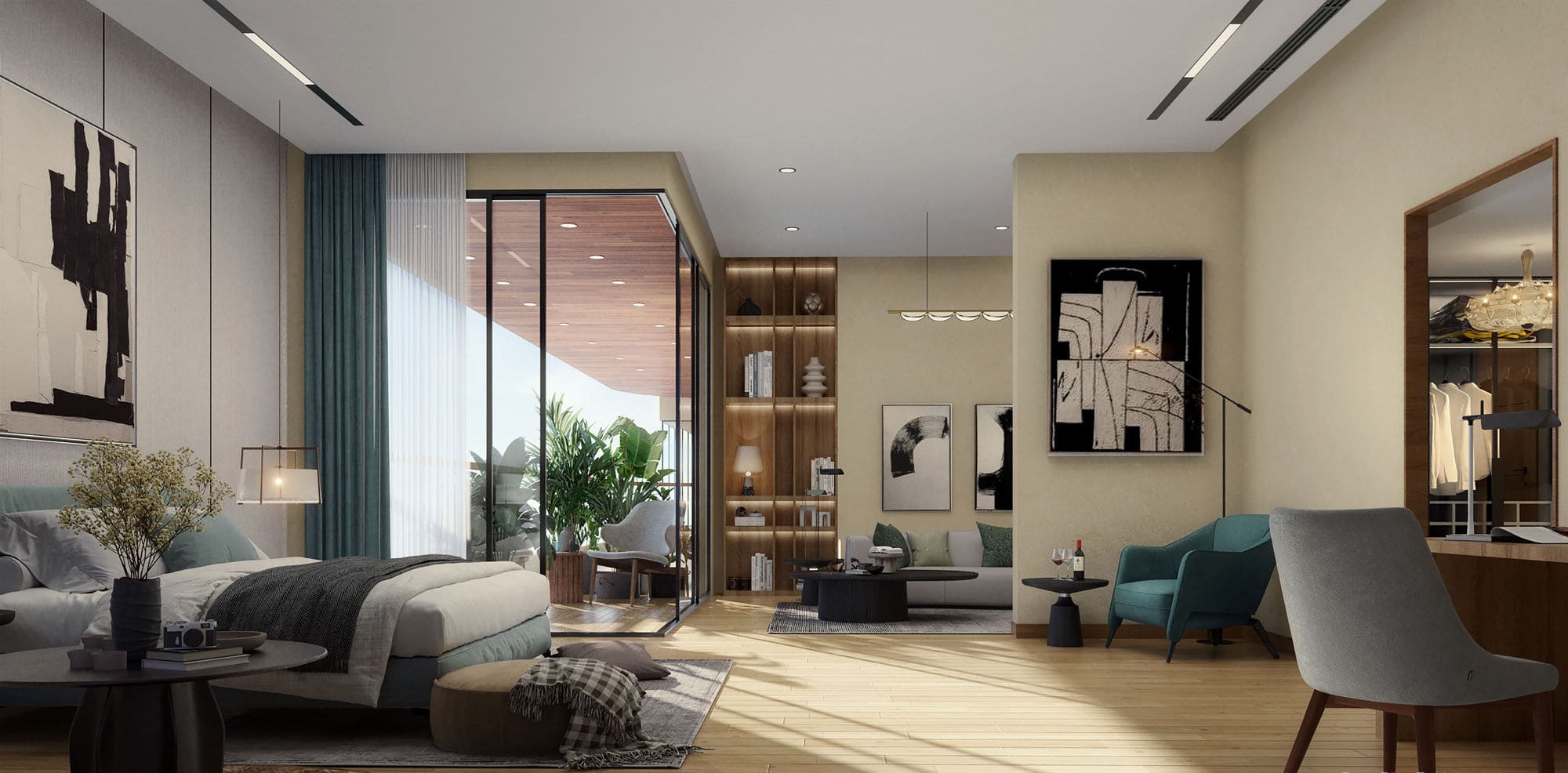
Rendering di cucine
Le cucine riguardano l’equilibrio tra bellezza e funzionalità. Un rendering è essenziale per visualizzare il layout, flusso di lavoro, e scelte materiali per mobili e controsoffitti.

Rendering di camere da letto
Una camera da letto è un santuario personale. Queste immagini mostrano i tessuti, tavolozze di colori, e il morbido, illuminazione a strati che fa sembrare la camera da letto un rifugio accogliente.

Rendering del bagno
In uno spazio più piccolo, Ogni dettaglio conta. I rendering del bagno sono perfetti per evidenziare i complessi lavori di piastrelle, infissi, e un senso di tranquillità simile a quello di una spa.
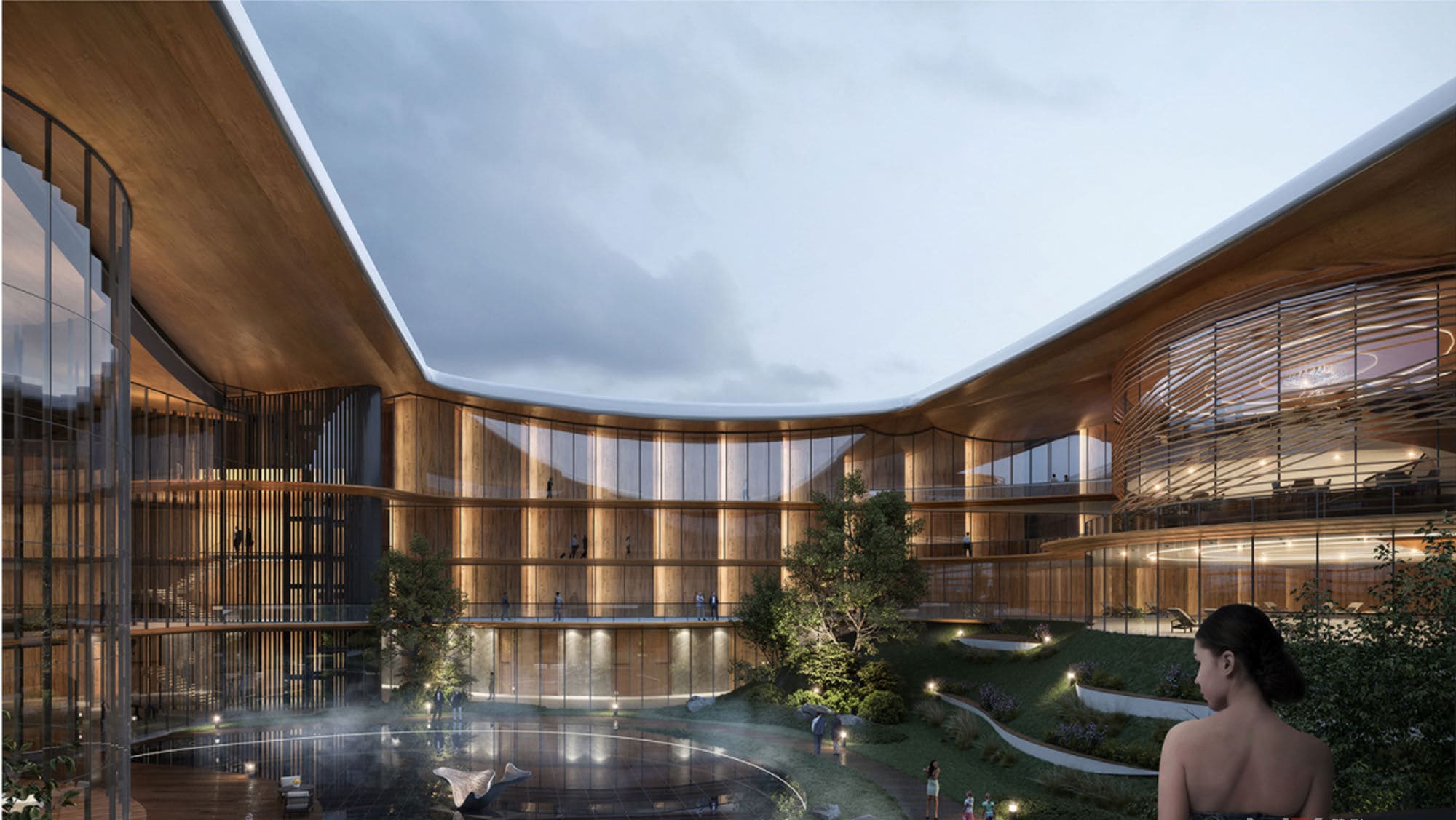
Rendering di uffici domestici
Un moderno ufficio in casa deve essere allo stesso tempo stimolante e funzionale. I rendering per questi spazi bilanciano l'estetica sofisticata con il comfort ergonomico.

Rendering di spazi commerciali (Ristoranti, Vedere al dettaglio, Hotel)
Per progetti commerciali, il rendering visualizza il marchio e l'esperienza del cliente, dalla disposizione dei posti a sedere in un ristorante all'esposizione dei prodotti in un negozio al dettaglio.

Parte 8: L'orizzonte: Qual è il futuro del rendering dell'interior design?
Il mondo della visualizzazione 3D non è fermo. La tecnologia si sta evolvendo a un ritmo mozzafiato, e gli strumenti a disposizione dei progettisti diventano ogni anno più potenti e intelligenti.

In che modo la tecnologia plasmerà il futuro della visualizzazione?
Il ruolo dell'intelligenza artificiale (AI) e apprendimento automatico
L’intelligenza artificiale sta già iniziando a semplificare il processo di rendering. Alimentato dall'intelligenza artificiale “denoising” può ridurre drasticamente i tempi di rendering. Nel prossimo futuro, possiamo aspettarci che l’intelligenza artificiale svolga un ruolo ancora più importante, potenzialmente suggerendo layout di progettazione o generando tavolozze di materiali basate su un mood board.
Rendering in tempo reale e maggiore interattività
L'ascesa di potenti motori di rendering in tempo reale, spesso preso in prestito dall'industria dei videogiochi, sta cambiando il gioco. Questi strumenti consentono a progettisti e clienti di navigare in uno spazio 3D fotorealistico in tempo reale. Immagina una presentazione in cui puoi cambiare il colore delle pareti o sostituire il pavimento e vedere immediatamente i risultati. Questo livello di interattività è il futuro della collaborazione con i clienti.
Sostenibilità e design ecocompatibile nella visualizzazione
Poiché la sostenibilità diventa più critica, il rendering sarà uno strumento chiave per visualizzare le scelte eco-compatibili. I progettisti possono simulare l’efficienza energetica di uno spazio o creare immagini accattivanti che mostrino la bellezza dei materiali sostenibili, aiutare i clienti a prendere decisioni più rispettose dell’ambiente.
Conclusione: La tua visione, Visualizzato
Abbiamo viaggiato attraverso il cosa, Perché, e come eseguire il rendering 3D del design degli interni. Abbiamo visto che è molto più di un semplice strumento per creare una bella immagine. È un pilastro fondamentale della pratica del design moderno, un catalizzatore per una comunicazione chiara, processo decisionale fiducioso, marketing efficace, e il successo finale del progetto.
Il valore fondamentale del rendering 3D risiede nella sua capacità unica di allineare perfettamente la visione creativa del progettista con le aspirazioni più profonde del cliente. Toglie il dubbio, crea eccitazione, e garantisce che la finale, lo spazio costruito è esattamente ciò che tutti sognavano che fosse.
Sia che tu stia intraprendendo un semplice rinnovamento della stanza o sviluppando una proprietà commerciale su larga scala, abbracciare la potenza della visualizzazione 3D è la chiave per sbloccare tutto il potenziale del tuo progetto. È ora di smetterla descrivendo la tua visione e inizia mostrando è sorprendente in tutto il suo aspetto, gloria fotorealistica.
Pronto a dare vita alla tua visione del design? Esplora professionale 3D Servizi di rendering oggi e fai il primo passo verso la trasformazione dei tuoi concetti in una realtà mozzafiato.


